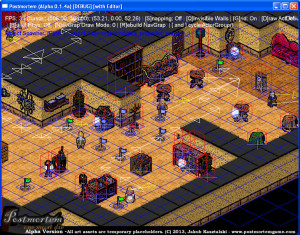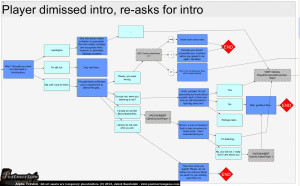Developing my indiePostmortem, I’ve been slowly growing a list of programming libraries, art assets, and content-creation tools; hopefully it is useful to you!
Update (July 21, 2013): Updated the document with latest info!
Programming
ThePostmortem is coded entirely in C++ using Microsoft Visual Studio as the IDE and compiler, but relies on several 3rd party libraries:

- SFML – awesome library that handles my graphics, audio, windowing, input, networking etc. Screw dealing with Win32!
- Boost – an all around programming library that adds a tons of useful classes and features to C++ (shared and weak pointers being the biggest ones I rely on). Don’t code without it!
- Bullet Physics – realtime, accurate 3D physics and collision library. Yes, in an isometric 2D . It’s more accurate and efficient than coding my own collision system.
- PugiXML – small XML parsing library
- Postmortem – I also have a built-ineditor for stuff like spawning/moving entities, designing the tilemap, previewing navgraph etc. Check the screenie on the right!
Creating Engine Assets
Don’t re-invent the wheel! If there’s a tool out there that nearly does what you need, then hacking or working around the extra features may save you more time than coding stuff yourself!

- yEd Graph Editor – a robust graph editor. I use it for my visual conversations and scripting system, taking advantage of customizable nodes and metadata.
- Notepad++ – More advanced notepad, with line numbers, syntax highlight, robust search and tons of plugins. My engine objects are stored in human-readable text files, so it’s invaluable for editing them!
- OggDropXPd – an audio encoder to the OGG format used by SFML audio library (music!)
- Adobe Photoshop / Soundbooth – for tweaking the art assets
Art Assets
All original art is made by our artists, Noah “HeartGear” Page and J. Flynn using tablets, Photoshop and Illustrator. The older placeholders were modified versions of sprites from Arcanum (objects) and Final Fantasy Tactics (characters). The temporary portraits are based on Public Domain Portraits assembled by qubodup from OpenGameArt.org.
The tiles I made myself using free textures from CGTextures, and some other temporary graphics (like viewable items, newspapers, etc.) are also taken from there plus some random google searches.
Music placeholders are currently from Arcanum plus one of my composer’s, Faetal, older tracks. SFX are custom made by our talented sound engineer, Felix Davin.
Other Resources
Here’s some other websites, tools and resources I found useful:
- Google Docs – For notes easily accessible from anywhere. I tried GANTs and Trello for timelining but ended up with good old spreadsheets – because why complicate things?
- Incompetech .com (Kevin MacLeod) – great repository of royalty-free music
- OpenGameArt – tons of mostly free 2D and 3D art resources (sprites, models, textures, etc.)
- The Sprite Resource – sprites ripped from numerous(NES/SNES/PC/PSX etc.)
- How to Contact Press (PixelProspector Blog) – a great, comprehensive document
- RunJumpDev Ben Kuchera – November 2011 – good Video on promotion and contacting press
- Indie marketing plan (Joost’s DevBlog) – another list of great marketing tips
- MAI Entertainment Lawyers – few good articles on the law behind , collaboration agreements, and art asset licensing
- Young Horses (Octoded) PressKit – great example of a solid presskit for an indie
- Trello – [NO LONGER USED] free online virtual notecard pinboard. With some tweaks, very useful for task-planning using a sprint-based Agile development cycle
- And more resources here – Good intro and bunch of useful links from IT Hare. Thanks for bringing to my attention, Sarah!
Hope this list proves useful to you and if you have questions about anything, just comment below. HappyMaking!